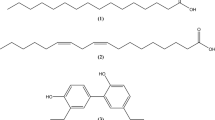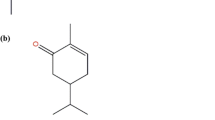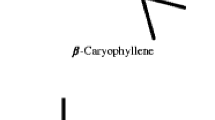Abstract
Emodin, a compound isolated from Aspergillus terreus, was studied using chromatographic and spectroscopic methods and compound purity (96%) was assessed by TLC. Furthermore, high larvicidal activity against Aedes aegypti-AeA (LC50 6.156 and LC90 12.450 mg/L), Culex quinquefasciatus-CuQ (8.216 and 14.816 mg/L), and Anopheles stephensi-AnS larvae (6.895 and 15.24 mg/L) was recorded. The first isolated fraction (emodin) showed higher pupicidal activity against AeA (15.449 and 20.752 mg/L). Most emodin-treated larvae (ETL) showed variations in acetylcholine esterase, α and β-carboxylesterases, and phosphatase activities in the 4th instar, indicating the intrinsic differences in their biochemical changes. ETL had numerous altered tissues, including muscle, gastric caeca, hindgut, midgut, nerve ganglia, and midgut epithelium. Acute toxicity of emodin on brine shrimp Artemia nauplii (54.0 and 84.5 mg/L) and the zebrafish Danio rerio (less toxicity observed) was recorded. In docking studies, Emodin interacted well with odorant-binding-proteins of AeA, AnS, and CuQ with docking scores of − 8.89, − 6.53, and − 8.09 kcal mol−1, respectively. Therefore, A. terreus is likely to be effective against mosquito larvicides.







Similar content being viewed by others
Data availability
During the present research entities, the datasets gathered and generated from the analysis after extraction/separation/isolation of compound emodin and evaluated biological results are available from the corresponding author on reasonable request.
References
Abbott WS (1925) A method of computing the effectiveness of an insecticide. J Econ Entomol 18:265–267
Abinaya M et al (2018) Structural characterization of Bacillus licheniformis Dahb1 exopolysaccharide—antimicrobial potential and larvicidal activity on malaria and Zika virus mosquito vectors. Environ Sci Pollut Res 25:18604–18619
Abutaha N et al (2015) Larvicidal activity of endophytic fungal extract of Cochliobolus spicifer (Pleosporales: Pleosporaceae) on Aedes caspius and Culex pipiens (Diptera: Culicidae). Appl Entomol Zool 50:405–414
Agra-Neto AC et al (2014) Effect of Moringa oleifera lectins on survival and enzyme activities of Aedes aegypti larvae susceptible and resistant to organophosphate. Parasitol Res 113:175–184
Anjum A et al (2012) Development and validation of RPHPLC method for the quantitative estimation of cefadroxil monohydrate in bulk and Pharmaceutical dosage forms. Int J Chem Sci 10:150–158
Asakura K (1978) Phosphatase activity in the larva of the euryhaline mosquito, Aedes togoi Theobald, with special reference to sea-water adaptation. J Exp Mar Biol Ecol 31:325–337
Bakkiyanathan A et al (2012) Anti-angiogenic effects of theophylline on developing zebrafish (Danio rerio) embryos. Biomed Prev Nutr 2:174–178
Bentley MD, Day JF (1989) Chemical ecology and behavioral aspects of mosquito oviposition. Annu Rev Entomol 34:401–421
Benton R et al (2009) Variant ionotropic glutamate receptors as chemosensory receptors in Drosophila. Cell 136:149–162
Bhatia R et al (2014) Vector-borne diseases in South-East Asia: burdens and key challenges to be addressed. WHO South-East Asia J Public Health 3:2–4
Braunbeck T et al (2015) The fish embryo test (FET): origin, applications, and future. Environ Sci Pollut Res 22:16247–16261
Busquet F et al (2008) Development of a new screening assay to identify proteratogenic substances using Zebrafish Danio rerio embryo combined with an exogenous mammalian metabolic activation system (m Dar T). Toxicol Sci 104:177–188
Busquet F et al (2014) OECD validation study to assess intra-and inter-laboratory reproducibility of the zebrafish embryo toxicity test for acute aquatic toxicity testing. Regul Toxicol Pharmacol 69:496–511
Cabrera M, Jaffe K (2007) An aggregation pheromone modulates lekking behavior in the vector mosquito Aedes aegypti (Diptera: Culicidae). J Am Mosq Control Assoc 23:1–10
Calvo E et al (2006) Function and evolution of a mosquito salivary protein family. J Biol Chem 281:1935–1942
Case DA, Babin V, Berryman JT, Betz RM, Cai Q, Cerutti DS, ... Kollman PA (2014) AMBER 14. University of California, San Francisco, pp 1–826
Chenniappan K, Kadarkarai M (2008) Oviposition deterrent, ovicidal and gravid mortality effects of ethanolic extract of Andrographis paniculata Nees against the malarial vector Anopheles stephensi Liston (Diptera: Culicidae). Entomol Res 38:119–125
da Silva OS et al (2013) Larvicidal and growth-inhibiting activities of extract and benzopyrans from Hypericum polyanthemum (Guttiferae) against Aedes aegypti (Diptera: Culicidae). Ind Crops Prod 45:236–239
da Silva GN et al (2016) Larvicidal activity of natural and modified triterpenoids against Aedes aegypti (Diptera: Culicidae). Pest Manag Sci 72:1883–1887
Dassault Systems (2016) BIOVIA. Discovery Studio Visualizer, v16.1.0.15350. Dassault Systems, San Diego
De Bruyne M, Baker TC (2008) Odor detection in insects: volatile codes. J Chem Ecol 34:882–897
Déciga-Campos M et al (2007) Acute toxicity and mutagenic activity of Mexican plants used in traditional medicine. J Ethnopharmacol 110:334–342
Deepika TL et al (2012) Isolation and characterisation of acaricidal and larvicidal novel compound (2S, 5R, 6R)-2-hydroxy-3, 5, 6-trimethyloctan-4-one from Streptomyces sp. against blood-sucking parasites. Parasitol Res 111:1151–1163
DeLano WL (2002) Pymol: an open-source molecular graphics tool. CCP4 Newsl. Protein Crystallogr 40:82–92
Demain AL, Fang A (2000) The natural functions of secondary metabolites. History Modern Biotechnol I:1–39
Dhivya R (2014) In silico molecular docking and molecular dynamics applications in the designing of a new mosquito repellent from the plant Calotropis gigantea targeting the odorant binding protein of Culex quinquefasciatus. Int J Pharm Phytopharmacological Res 3(2)
Edwin E-S et al (2016) Anti-dengue efficacy of bioactive andrographolide from Andrographis paniculata (Lamiales: Acanthaceae) against the primary dengue vector Aedes aegypti (Diptera: Culicidae). Acta Trop 163:167–178
Ellman GL et al (1961) A new and rapid colorimetric determination of acetylcholinesterase activity. Biochem Pharmacol 7:88–95
Elumalai D et al (2016) Larvicidal activity of catechin isolated from Leucas aspera against Aedes aegypti, Anopheles stephensi, and Culex quinquefasciatus (Diptera: Culicidae). Parasitol Res 115:1203–1212
Eswar N et al (2006) Comparative protein structure modeling using Modeller. Curr Protoc Bioinformatics 15:5.6.1-5.6.30
Fan Y-Q et al (2015) Alkaloids with cardiovascular effects from the marine-derived fungus Penicillium expansum Y32. Mar Drugs 13:6489–6504
Finney DJ (1971) Probit analysis. Cambridge University Press, London, pp 68–78
Foster WA, Hancock R (1994) Nectar-related olfactory and visual attractants for mosquitoes. J Am Mosq Control Assoc 10:288–296
Frisch MJ, Trucks GW, Schlegel HB, Scuseria GE, Robb MA, Cheeseman JR, ... Replogie ES (2004) Pople. Gaussian 03, Revision C. 02. Gaussian, Wallingford CT
Ga’al H et al (2018) Synthesis, characterization and efficacy of silver nanoparticles against Aedes albopictus larvae and pupae. Pestic Biochem Physiol 144:49–56
Gaddaguti V et al (2012) GCMS analysis and in silico molecular docking studies of mosquito repellent compounds from Hyptis suaveolens. Int J Bioassays 1:36–41
Gaddaguti V et al (2016) Potential mosquito repellent compounds of Ocimum species against 3N7H and 3Q8I of Anopheles gambiae. 3 Biotech 6:1–8
Gade S et al (2017) Acetylcholinesterase inhibitory activity of stigmasterol & hexacosanol is responsible for larvicidal and repellent properties of Chromolaena odorata. Biochimica et Biophysica Acta (BBA)-General Subjects. 1861:541–550
Gandhi M et al (2016) Larvicidal and pupicidal activities of alizarin isolated from roots of Rubia cordifolia against Culex quinquefasciatus Say and Aedes aegypti (L.)(Diptera: Culicidae). Neotrop Entomol 45:441–448
Geetha I et al (2010) Identification and characterization of a mosquito pupicidal metabolite of a Bacillus subtilis subsp. subtilis strain. Appl Microbiol Biotechnol 86:1737–1744
Georgalas V et al (2007) Swimming activity and feeding behaviour of larval European sea bass (Dicentrarchus labrax L): effects of ontogeny and increasing food density. Aquaculture 264:418–427
Gopal JV, Kannabiran K (2013) Studies on interaction of insect repellent compounds with odorant binding receptor proteins by in silico molecular docking approach. Interdiscip Sci: Computational Life Sciences 5:280–285
Guo S, Feng B, Zhu R, Ma J, Wang W (2011) Preparative isolation of three anthraquinones from Rumex japonicus by high-speed counter-current chromatography. Molecules 16(2):1201–1210
Kaewnang-O E, Ngampongsai A, Subhadhirasakul S, Srichana T (2011) Toxicity of fixed oil and crude extract from sa-dao-thiam, Azadirachta excelsa (Jack) seed kernel to Aedes aegypti (L.). Songklanakarin J Sci Technol 33(1)
Kamaraj C et al (2011) Larvicidal activity of medicinal plant extracts against Anopheles subpictus & Culex tritaeniorhynchus. Indian J Med Res 134:101
Karthik L et al (2011) Larvicidal, repellent, and ovicidal activity of marine actinobacteria extracts against Culex tritaeniorhynchus and Culex gelidus. Parasitol Res 108:1447–1455
Khan MSA et al (2018) Anti-nociceptive mechanisms of flavonoids-rich methanolic extract from Terminalia coriacea (Roxb.) Wight & Arn. leaves. Food Chem Toxicol 115:523–531
Kihampa C et al (2009) Larvicidal and IGR activity of extract of Tanzanian plants against malaria vector mosquitoes. J Vector Borne Dis 46:145
Koech PKA, Mwangi RW (2013) Repellent activities of Ocimum basilicum, Azadirachta indica and Eucalyptus citriodora extracts on rabbit skin against Aedes aegypti. http://hdl.handle.net/11295/81174
Koodalingam A et al (2011) Effects of extract of soapnut Sapindus emarginatus on esterases and phosphatases of the vector mosquito, Aedes aegypti (Diptera: Culicidae). Acta Trop 118:27–36
Kulkarni P, Gupta N (2013) Screening and evaluation of soil fungal isolates for xylanase production. Recent Res Sci Technol 5(2)
Lee S et al (2002) Brine shrimp lethality of the compounds fromPhryma leptostachya L. Arch Pharmacal Res 25:652–654
Lee B-M et al (2017) Lu’s basic toxicology: fundamentals, target organs, and risk assessment. CRC Press
Li Q et al (2016) Acute toxicity and histopathological effects of naproxen in zebrafish (Danio rerio) early life stages. Environ Sci Pollut Res 23:18832–18841
Liang Y et al (2015) Toxicity of amorphigenin from the seeds of Amorpha fruticosa against the larvae of Culex pipiens pallens (Diptera: Culicidae). Molecules 20:3238–3254
Lin S-Y et al (2009) Emodin induces apoptosis of human tongue squamous cancer SCC-4 cells through reactive oxygen species and mitochondria-dependent pathways. Anticancer Res 29:327–335
Lu T et al (2007) Odor coding in the maxillary palp of the malaria vector mosquito Anopheles gambiae. Curr Biol 17:1533–1544
McRae J et al (2007) Review of the methods used for isolating pharmaceutical lead compounds from traditional medicinal plants. Environmentalist 27:165–174
Meyer B et al (1982) Brine shrimp: a convenient general bioassay for active plant constituents. Planta Med 45:31–34
Minguez L et al (2016) Toxicities of 48 pharmaceuticals and their freshwater and marine environmental assessment in northwestern France. Environ Sci Pollut Res 23:4992–5001
Morris GM et al (2009) AutoDock4 and AutoDockTools4: automated docking with selective receptor flexibility. J Comput Chem 30:2785–2791
Müller GC et al (2009) Efficacy of the botanical repellents geraniol, linalool, and citronella against mosquitoes. J Vector Ecol 34:2–8
Murugesan A et al (2009) Biolarvicidal activity of extracellular metabolites of the keratinophilic fungus Trichophyton mentagrophytes against arvae of Aedes aegypti—a major vector for Chikungunya and dengue. Folia Microbiol 54:213–216
Nathan SS et al (2007) Food consumption, utilization, and detoxification enzyme activity of the rice leaffolder larvae after treatment with Dysoxylum triterpenes. Pestic Biochem Physiol 88:260–267
OECD (1992) Guidelines for the Testing of Chemicals: 203—Fish, Acute Toxicity Test. OECD Library
OECD (2013) Guideline for testing of chemicals, 236. Fish Embryo Acute Toxicity (FET) Test. OECD, Paris. Available at: http://www.oecd.org
Pandey V et al (2011) In vitro isolation and characterization of biolarvicidal compounds from micropropagated plants of Spilanthes acmella. Parasitol Res 108:297–304
Perumalsamy H et al (2015) Larvicidal activity and possible mode of action of four flavonoids and two fatty acids identified in Millettia pinnata seed toward three mosquito species. Parasit Vectors 8:1–14
Pradeep FS et al (2015) Larvicidal activity of a novel isoquinoline type pigment from Fusarium moniliforme KUMBF1201 against Aedes aegypti and Anopheles stephensi. Process Biochem 50:1479–1486
Prakash A (1993) Ovicidal action of certain chitin synthesis inhibitors in mosquitoes. Entomon-Trivandrum 17:15–15
Ragavendran C, Natarajan D (2015) Insecticidal potency of Aspergillus terreus against larvae and pupae of three mosquito species Anopheles stephensi, Culex quinquefasciatus, and Aedes aegypti. Environ Sci Pollut Res 22:17224–17237
Ragavendran C, Srinivasan R, Kim M, Natarajan D (2018) Aspergillus terreus (Trichocomaceae): a natural, eco-friendly mycoinsecticide for control of malaria, filariasis, dengue vectors and its toxicity assessment against an aquatic model organism Artemia nauplii. Front Pharmacol 9(1355):1–18
Ramachandran GN, Sasisekharan V (1968) Conformation of polypeptides and proteins. Adv Protein Chem 23:283–438
Ramachandran GN et al (1963) Stereochemistry of polypeptide chain configurations. J Mol Biol 7:95–99
Reegan AD et al (2016) In silico molecular docking of niloticin with acetylcholinesterase 1 (AChE1) of Aedes aegypti L. (Diptera: Culicidae): a promising molecular target. Med Chem Res 25:1411–1419
Saurav K et al (2013) Larvicidal activity of isolated compound 5-(2, 4-dimethylbenzyl) pyrrolidin-2-one from marine Streptomyces VITSVK5 sp. against Rhipicephalus (Boophilus) microplus, Anopheles stephensi, and Culex tritaeniorhynchus. Parasitol Res 112:215–226
Scholz S et al (2014) Extensive review of fish embryo acute toxicities for the prediction of GHS acute systemic toxicity categories. Regul Toxicol Pharmacol 69:572–579
Seetharaman P et al (2017) Isolation of limonoid compound (Hamisonine) from endophytic fungi Penicillium oxalicum LA-1 (KX622790) of Limonia acidissima L. for its larvicidal efficacy against LF vector, Culex quinquefasciatus (Diptera: Culicidae). Environ Sci Pollut Res 24:21272–21282
Selin-Rani S et al (2016) Toxicity of Alangium salvifolium Wang chemical constituents against the tobacco cutworm Spodoptera litura Fab. Pestic Biochem Physiol 126:92–101
Selvaraj K et al (2021) Larvicidal activity of novel anthraquinone analogues and their molecular docking studies. Saudi J Biol Sci 28:157–162
Sengottayan S-N (2013) Physiological and biochemical effect of neem and other Meliaceae plants secondary metabolites against Lepidopteran insects. Front Physiol 4:359
Sharma A, Kumar S, Tripathi P (2015) Impact of Achyranthes aspera leaf and stem extracts on the survival, morphology and behaviour of an Indian strain of dengue vector, Aedes aegypti L.(Diptera: Culicidae). J Mosq Res 5(7):1–9
Solairaj D, Rameshthangam P (2017) Silver nanoparticle embedded α-chitin nanocomposite for enhanced antimicrobial and mosquito larvicidal activity. J Polym Environ 25:435–452
Songa EA, Okonkwo JO (2016) Recent approaches to improving selectivity and sensitivity of enzyme-based biosensors for organophosphorus pesticides: A review. Talanta 155:289–304
Su T, Mulla M (1998) Ovicidal activity of neem products (azadirachtin) against Culex tarsalis and Culex quinquefasciatus (Diptera: Culicidae). J Am Mosq Control Assoc 14:204–209
Suryawanshi RK et al (2015) Mosquito larvicidal and pupaecidal potential of prodigiosin from Serratia marcescens and understanding its mechanism of action. Pestic Biochem Physiol 123:49–55
Tabanca N et al (2013) Bioassay-guided investigation of two Monarda essential oils as repellents of yellow fever mosquito Aedes aegypti. J Agric Food Chem 61:8573–8580
Takken W (1991) The role of olfaction in host-seeking of mosquitoes: a review. Int J Trop Insect Sci 12:287–295
Tegoni M et al (2004) Structural aspects of sexual attraction and chemical communication in insects. Trends Biochem Sci 29:257–264
Van Asperen K (1962) A study of housefly esterases by means of a sensitive colorimetric method. J Insect Physiol 8:401–416
Venkateswara Rao J et al (2007) Toxicity of organophosphates on morphology and locomotor behavior in brine shrimp, Artemia salina. Arch Environ Contam Toxicol 53:227–232
Vieira FG, Rozas J (2011) Comparative genomics of the odorant-binding and chemosensory protein gene families across the Arthropoda: origin and evolutionary history of the chemosensory system. Genome Biol Evol 3:476–490
Vijayakumari B et al (2016) In silico analysis of aqueous root extract of Rotula aquatica Lour for docking analysis of the compound 3-O-acetyl-11-keto-β-boswellic acid contents. Springerplus 5:1–8
Vinayagam A et al (2008) Larvicidal activity of some medicinal plant extracts against malaria vector Anopheles stephensi. Res J Parasitol 3:50–58
Ward M, Benelli G (2017) Avian and simian malaria: do they have a cancer connection? Parasitol Res 116:839–845
World Health Organization (1996) Report of the WHO Informal Consultation on the Evaluation and Testing of Insecticides. WHO/HQ, Geneva, 7 to 11 October 1996 (No. CTD/WHOPES/IC/96.1). World Health Organization
Yang Y-C et al (2003) Emodin isolated from Cassia obtusifolia (Leguminosae) seed shows larvicidal activity against three mosquito species. J Agric Food Chem 51:7629–7631
Zhang L-H et al (2013) Isolation and structural speculation of herbicide-active compounds from the metabolites of Pythium aphanidermatum. J Integr Agric 12:1026–1032
Acknowledgements
The first author expresses his heartfelt gratitude to the Council of Scientific and Industrial Research (CSIR), Government of India, New Delhi, for awarding a CSIR-SRF (Direct) Fellowship (Award Ref. Lr.09/810 (0024)/2016-EMR-I dated 30/03/2017). We would also like to appreciate the DST-FIST [SR/FIST/LSI-673/2016] programme for its assistance of the Biotechnology Department at Periyar University in order to improve the instrumental facility. We would like to thank the Department of Biotechnology, School of Biosciences, Periyar University for providing the laboratory facilities required to complete this study successfully. This research work was partially supported by Chiang Mai University, Thailand.
Author information
Authors and Affiliations
Contributions
The general design and planning of the experiment, larval data processing, and result interpretation were all provided by CR, GB, MS, PW, VP, SSN, PK, and DN. The molecular docking investigation and interpretation were carried out by MS and CR. The brine shrimp test toxicity experiments were carried out by CR. The embryo toxicity test was carried out by VM. The manuscript was co-written by CR, GB, PW, VP, SSN, PK, and DN. The final document has been thoroughly examined and authorized for publication by all of the writers and special contribution by DA, PK, and DN.
Corresponding author
Ethics declarations
The present research entities does not contain any studies with human participants or animals performed by any of the authors.
Ethics approval and consent to participate
Not applicable.
Consent for publication
Not applicable.
Conflict of interest
The authors declare no competing interests.
Additional information
Responsible Editor: Philippe Garrigues
Publisher's note
Springer Nature remains neutral with regard to jurisdictional claims in published maps and institutional affiliations.
Supplementary Information
Below is the link to the electronic supplementary material.
Rights and permissions
Springer Nature or its licensor (e.g. a society or other partner) holds exclusive rights to this article under a publishing agreement with the author(s) or other rightsholder(s); author self-archiving of the accepted manuscript version of this article is solely governed by the terms of such publishing agreement and applicable law.
About this article
Cite this article
Chinnasamy, R., Govindasamy, B., Venkatesh, M. et al. Bio-efficacy of insecticidal molecule emodin against dengue, filariasis, and malaria vectors. Environ Sci Pollut Res 30, 61842–61862 (2023). https://doi.org/10.1007/s11356-023-26290-0
Received:
Accepted:
Published:
Issue Date:
DOI: https://doi.org/10.1007/s11356-023-26290-0




